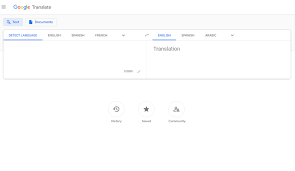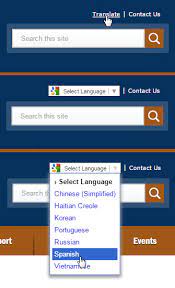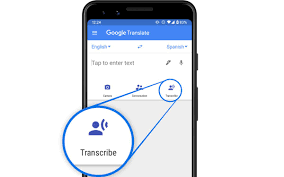Google Translate: Breaking Language Barriers with Technology
In today’s interconnected world, effective communication is key. However, language barriers often hinder our ability to connect with people from different cultures and backgrounds. That’s where Google Translate comes in, revolutionizing the way we bridge these gaps and enabling us to communicate effortlessly across languages.
Google Translate is a free online translation service developed by Google. It utilizes advanced machine learning algorithms and neural networks to provide quick and accurate translations between more than 100 languages. Whether you need to translate a simple phrase or an entire document, Google Translate has become the go-to tool for millions of users worldwide.
One of the standout features of Google Translate is its ease of use. With a simple and intuitive interface, anyone can access this powerful translation tool with just a few clicks. You can enter text manually or even use the camera on your smartphone to translate signs, menus, or any printed text instantly. This makes it incredibly convenient for travelers or individuals encountering unfamiliar languages in their daily lives.
Accuracy is another area where Google Translate shines. Thanks to its advanced algorithms that continuously learn from vast amounts of data, the translations provided by Google Translate have significantly improved over time. While it may not always be perfect, it offers a reliable starting point for understanding foreign texts or communicating basic ideas across languages.
Google Translate also goes beyond mere word-for-word translations. It takes into account context and idiomatic expressions to deliver more natural-sounding results. This is particularly helpful when trying to grasp the nuances and subtleties of different languages.
Furthermore, Google Translate isn’t limited to just text translation. It also offers speech-to-text and text-to-speech capabilities, allowing users to have real-time conversations with people who speak different languages. This feature has proven invaluable in breaking down language barriers during international meetings, conferences, or even casual conversations between friends from different linguistic backgrounds.
While Google Translate has undoubtedly revolutionized language translation, it’s important to note that it is not without its limitations. Translations can sometimes be literal or lack the cultural nuances that make a language unique. It’s always advisable to consult with a professional translator for critical or sensitive content.
In conclusion, Google Translate has transformed the way we communicate across languages. By providing quick and accessible translations, it has become an indispensable tool for individuals, businesses, and travelers alike. As technology continues to advance, we can expect even more accurate and nuanced translations, further breaking down language barriers and fostering greater global understanding.
8 Frequently Asked Questions About Google Translate
- How do I use Google Translate?
- What languages does Google Translate support?
- How accurate is Google Translate?
- Is Google Translate free to use?
- How do I type in a foreign language using Google Translate?
- Does Google Translate support voice input?
- Can I download the translation for offline use with Google Translate?
- Does Google Translate offer translations for specialized texts such as legal or medical documents?
How do I use Google Translate?
Using Google Translate is incredibly simple. Here’s a step-by-step guide on how to use it:
Access Google Translate: Open your web browser and go to translate.google.com. Alternatively, you can download the Google Translate app on your smartphone or tablet from the App Store (iOS) or Google Play Store (Android).
Select Languages: On the main page of Google Translate, you’ll see two drop-down menus labeled “From” and “To.” Choose the language you want to translate from in the “From” menu and the language you want to translate to in the “To” menu. You can select from a wide range of languages.
Enter Text: There are different ways to enter text for translation:
– Type: Simply type or paste your text into the input box on the left side of the screen.
– Speak: If you’re using the mobile app, tap on the microphone icon and speak your text aloud for automatic speech recognition.
– Handwriting: On the web version, click on the pen icon and use your mouse or touchpad to write characters or words.
View Translation: As you enter text, Google Translate will instantly provide a translation on the right side of the screen. You can see both written translations and hear audio playback by clicking on the speaker icon.
Additional Features:
– Camera Translation: On mobile devices, tap on the camera icon to access visual translation mode. Point your camera at printed text, such as signs or menus, and Google Translate will overlay translations in real-time.
– Conversation Mode: In the mobile app, there’s a conversation feature that allows you to have bilingual conversations with someone else. Each person speaks into their device, and Google Translate translates their speech back and forth.
Copy or Share Translations: If you want to copy a translation or share it with others, simply click on the copy icon or the share icon to access various sharing options, such as email or messaging apps.
That’s it! You’re now ready to use Google Translate to break down language barriers and communicate effectively across different languages.
What languages does Google Translate support?
Google Translate supports a wide range of languages, making it one of the most comprehensive translation tools available. As of now, it can translate text and provide other language-related services for over 100 languages. This includes popular languages such as English, Spanish, French, German, Chinese (Simplified and Traditional), Japanese, Korean, Arabic, Russian, Portuguese, Italian, Dutch, Polish, Swedish, Norwegian, Danish, Finnish, Greek, Hindi, Turkish, and many more.
In addition to these widely spoken languages, Google Translate also supports translations for less commonly spoken languages and dialects. This demonstrates Google’s commitment to inclusivity and ensuring that people from diverse linguistic backgrounds can access translation services.
It’s important to note that while Google Translate offers translations for a vast number of languages, the quality and availability of certain language pairs may vary. Some languages may have more robust translation capabilities than others due to factors such as data availability and linguistic complexity.
Google continues to expand its language support and improve the accuracy of translations by leveraging advancements in artificial intelligence and machine learning. As technology progresses and linguistic resources become more accessible, we can expect Google Translate to support an even wider array of languages in the future.
How accurate is Google Translate?
Google Translate has made significant advancements in accuracy over the years, thanks to the implementation of advanced machine learning algorithms and neural networks. However, it’s important to note that while Google Translate can provide a good understanding of the general meaning of a text, it may not always deliver perfect or nuanced translations.
The accuracy of Google Translate can vary depending on several factors:
- Language Pair: The accuracy may differ between popular languages that have been extensively trained on large amounts of data and less common languages with limited available resources.
- Context: Translations heavily rely on context, and Google Translate may struggle with ambiguous or context-dependent phrases. It’s important to keep in mind that translations without proper context may not capture the intended meaning accurately.
- Grammar and Syntax: Languages have different grammatical rules and structures, which can be challenging for translation algorithms to handle perfectly. Complex sentence structures or idiomatic expressions might be translated less accurately.
- Technical Terminology or Jargon: Specialized fields often have specific terminology that might not be well-incorporated into Google Translate’s database. In such cases, translations may be less accurate or require manual intervention.
- Cultural Nuances: Languages are deeply intertwined with culture, and certain phrases or idioms may not have direct equivalents in other languages. This can result in translations that lack the cultural nuances present in the original text.
While Google Translate continues to improve its accuracy through ongoing updates and advancements, it’s always advisable to use it as a starting point for understanding foreign texts rather than relying solely on its translations for critical or sensitive content. For important documents or professional purposes, consulting with a human translator is still recommended to ensure accurate and culturally appropriate translations.
Is Google Translate free to use?
Yes, Google Translate is free to use for individuals. It is available as a web-based service and also as a mobile application for iOS and Android devices. Users can access and utilize its translation capabilities without any cost. This accessibility has made it widely popular and widely used by millions of people around the world.
How do I type in a foreign language using Google Translate?
To type in a foreign language using Google Translate, follow these steps:
- Open your web browser and go to translate.google.com.
- On the left side of the translation box, you’ll see a drop-down menu labeled “Detect language.” Click on it and select the language you want to type in.
- Once you have selected the desired language, click inside the translation box.
- A virtual keyboard will appear on the screen with keys representing the characters of the selected language. You can either use your mouse to click on the virtual keys or use your physical keyboard to type.
- Start typing in the foreign language using either method mentioned above. As you type, Google Translate will automatically detect and display the translation in real-time on the right side of the translation box.
- If needed, you can copy and paste the translated text into another application or document.
It’s important to note that not all languages have virtual keyboards available in Google Translate. In such cases, you may need to enable an appropriate keyboard layout on your device or use an external input method for typing in that specific language.
Does Google Translate support voice input?
Yes, Google Translate supports voice input, making it even more convenient for users. With the voice input feature, you can simply speak into your device’s microphone and have your words translated in real-time. This functionality is available on both the web version and the mobile app of Google Translate.
To use voice input in Google Translate, you need to select the microphone icon located in the input box. Once activated, you can start speaking in your desired language, and Google Translate will convert your speech into text. It will then provide a translation of what you said in the selected target language.
Voice input is particularly useful when you are on-the-go or when typing is not practical or efficient. It allows for quick and hands-free translation, making it easier to communicate with people who speak different languages.
It’s important to note that while Google Translate’s voice recognition technology is quite advanced, there may be some limitations depending on factors such as background noise or accents. However, overall, it remains a valuable tool for facilitating spoken communication across languages.
Can I download the translation for offline use with Google Translate?
Yes, you can download translations for offline use with the Google Translate app. This feature is especially useful when you are traveling or in an area with limited or no internet connectivity.
To download translations, follow these steps:
- Download the Google Translate app from the App Store (iOS) or Google Play Store (Android) if you haven’t already.
- Open the app and make sure you are signed in to your Google account.
- Tap on the language pair at the top of the screen to select the languages you want to translate between.
- At the bottom of the screen, you will see a text box. Enter or paste the text you want to translate.
- Tap on the “Translate” button to see the translation.
- To download this translation for offline use, tap on the “Download” button next to it.
Once downloaded, you can access your offline translations by going to the “Saved” tab in the app’s main menu. Here, you will find all your downloaded translations organized by language pairs.
It’s important to note that not all languages are available for offline translation, and some language pairs may require a larger download size due to their complexity. Also, keep in mind that offline translations may not be as accurate or comprehensive as online translations since they rely on pre-downloaded data.
By enabling offline translation with Google Translate, you can have access to translations even when an internet connection is unavailable, making it a valuable tool for communication in various situations.
Does Google Translate offer translations for specialized texts such as legal or medical documents?
Yes, Google Translate can provide translations for specialized texts such as legal or medical documents. However, it’s important to note that while Google Translate has made significant improvements in accuracy and context understanding, it may not always capture the intricacies and specific terminology associated with these specialized fields.
When it comes to critical or sensitive content, it is advisable to consult with a professional translator who specializes in the relevant domain. Professional translators have the expertise and knowledge required to accurately translate legal, medical, or other specialized texts while considering the specific terminology and nuances of those fields.
Google Translate can still be a useful tool for getting a general understanding of such texts or for quick reference. It can help you grasp the main ideas or extract key information from documents. However, for accurate and reliable translations of specialized content, it’s always recommended to seek assistance from qualified human translators who are experienced in handling these types of materials.



